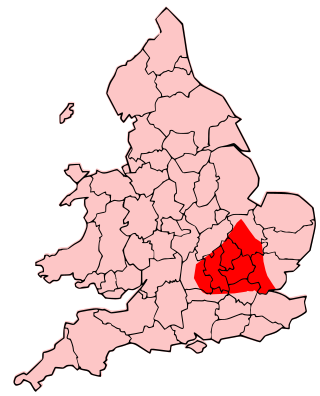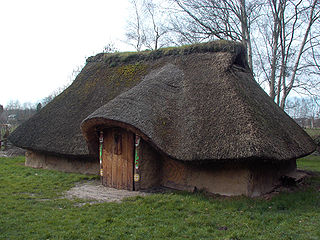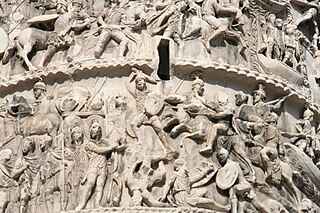
The Bastarnae, sometimes called the Peuci or Peucini, were an ancient people who between 200 BC and 300 AD inhabited areas north of the Roman frontier on the Lower Danube. The Bastarnae lived in the region between the Carpathian Mountains and the river Dnieper, to the north and east of ancient Dacia. The Peucini were a subtribe who occupied the region north of the Danube Delta. Their name was sometimes used for the Bastarnae as a whole.

The Suebi or Suebians were a large group of Germanic peoples originally from the Elbe river region in what is now Germany and the Czech Republic. In the early Roman era they included many peoples with their own names such as the Marcomanni, Quadi, Hermunduri, Semnones, and Lombards. New groupings formed later, such as the Alamanni and Bavarians, and two kingdoms in the Migration Period were simply referred to as Suebian.

The Chatti were an ancient Germanic tribe whose homeland was near the upper Weser (Visurgis), whose name might mean "pursuers". They lived in central and northern Hesse and southern Lower Saxony, along the upper reaches of that river and in the valleys and mountains of the Eder and Fulda regions, a district approximately corresponding to Hesse-Kassel, though probably somewhat more extensive. They settled within the region in the first century BC. According to Tacitus, the Batavians and Cananefates of his time, tribes living within the Roman Empire, were descended from part of the Chatti, who left their homeland after an internal quarrel drove them out, to take up new lands at the mouth of the Rhine.

The Cherusci were a Germanic tribe that inhabited parts of the plains and forests of northwestern Germany in the area of the Weser River and present-day Hanover during the first centuries BC and AD. Roman sources reported they considered themselves kin with other Irmino tribes and claimed common descent from an ancestor called Mannus. During the early Roman Empire under Augustus, the Cherusci first served as allies of Rome and sent sons of their chieftains to receive Roman education and serve in the Roman army as auxiliaries. The Cherusci leader Arminius led a confederation of tribes in the ambush that destroyed three Roman legions in the Teutoburg Forest in AD 9. He was subsequently kept from further damaging Rome by disputes with the Marcomanni and reprisal attacks led by Germanicus. After rebel Cherusci killed Arminius in AD 21, infighting among the royal family led to the highly Romanized line of his brother Flavus coming to power. Following their defeat by the Chatti around AD 88, the Cherusci do not appear in further accounts of the German tribes, apparently being absorbed into the late classical groups such as the Saxons, Thuringians, Franks, Bavarians, and Allemanni.

The Quadi were a Germanic people who lived approximately in the area of modern Moravia in the time of the Roman Empire. The only surviving contemporary reports about the Germanic tribe are those of the Romans, whose empire had its border on the River Danube just to the south of the Quadi. They associated the Quadi with their neighbours the Marcomanni, and described both groups as having entered the region after the Celtic Boii had left it deserted. The Quadi may later have contributed to the "Suebian" group who crossed the Rhine with the Vandals and Alans in the 406 Crossing of the Rhine, and later founded a kingdom in northwestern Iberia.

The Lugii were a large tribal confederation mentioned by Roman authors living in ca. 100 BC–300 AD in Central Europe, north of the Sudetes mountains in the basin of upper Oder and Vistula rivers, covering most of modern southern and middle Poland.

The Catuvellauni were a Celtic tribe or state of southeastern Britain before the Roman conquest, attested by inscriptions into the 4th century.

The Menapii were a Belgic tribe dwelling near the North Sea, around present-day Cassel, during the Iron Age and the Roman period.

The Usipetes or Usipii were an ancient tribe who moved into the area on the right bank of the lower Rhine in the first century BC, putting them in contact with Gaul and the Roman empire. They are known first from the surviving works of ancient authors such as Julius Caesar and Tacitus. They appear to have moved position several times before disappearing from the historical record.

The Remi were a Belgic tribe dwelling in the Aisne, Vesle and Suippe river valleys during the Iron Age and the Roman period. Their territory roughly corresponded the modern Marne and Ardennes and parts of the Aisne and Meuse departments.

The Hermunduri, Hermanduri, Hermunduli, Hermonduri, or Hermonduli were an ancient Germanic tribe, who occupied an inland area near the source of the Elbe river, around what is now Bohemia from the first to the third century, though they have also been speculatively associate with Thuringia further north. According to an old proposal based on the similarity of the names, the Thuringii may have been the descendants of the Hermunduri. At times, they apparently moved to the Danube frontier with Rome. Claudius Ptolemy mentions neither tribe in his geography but instead the Teuriochaemae, who may also be connected to both.

The Chamavi, Chamãves or Chamaboe (Χαμαβοί) were a Germanic tribe of Roman imperial times whose name survived into the Early Middle Ages. They first appear under that name in the 1st century AD Germania of Tacitus as a Germanic tribe that lived to the north of the Lower Rhine. Their name probably survives in the region today called Hamaland, which is in the Gelderland province of the Netherlands, between the IJssel and Ems rivers.

The so-called Free Dacians is the name given by some modern historians to those Dacians who putatively remained outside, or emigrated from, the Roman Empire after the emperor Trajan's Dacian Wars. Dio Cassius named them Dakoi prosoroi meaning "neighbouring Dacians".
The Baemi or Baimoi, were a large Germanic people who are only known by their mention in Ptolemy's Geography. He described them as living on the north side of the Danube, south of the Luna forest and iron mines, with the Quadi still further north and the Hercynian forest above them. West of the Baemi on the Danube were the Adrabaecampi, who had the Sudini north of them, the Marcomanni still further north, and a forest called the Gabreta north of them. This would place them in or around modern Slovakia, Moravia and Lower Austria.
The 'Baenochaemae, Bainochaimai were a Germanic people recorded only in the Geography of Claudius Ptolemy, who described them as living near the Elbe.

The Buri were a Germanic tribe mentioned in the Germania of Tacitus, where they initially "close the back" of the Marcomanni and Quadi of Bohemia and Moravia. It is said that their speech and customs were like those of the Suebi. Such a statement implies that the Buri had recently come from the direction of the Baltic Sea, as other Germanic settlers in Bohemia and Moravia were newcomers, having driven out the Celtic Boii, or more likely absorbing and incorporating them after defeating them in battle and establishing a new authority. In Tacitus, the Buri are not linked to the Lugii.

The Marcomannic Wars were a series of wars lasting from about 166 until 180 AD. These wars pitted the Roman Empire against principally the Germanic Marcomanni and Quadi and the Sarmatian Iazyges; there were related conflicts with several other Germanic, Sarmatian and Gothic peoples along both sides of the whole length of the Roman Empire's northeastern European border, the river Danube.

The Anartes were Celtic tribes, or, in the case of those sub-groups of Anartes which penetrated the ancient region of Dacia, Celts culturally assimilated by the Dacians.

The Vacomagi were a people of ancient Britain, known only from a single mention of them by the geographer Claudius Ptolemy. Their principal places are known from Ptolemy's map c.150 of Albion island of Britannia – from the First Map of Europe.

Slovakia was partly occupied by Roman legions for a short period of time. Marcomannia was a proposed province of the Roman Empire that Emperor Marcus Aurelius planned to establish in this territory. It was inhabited by the Germanic tribes of Marcomanni and Quadi, and lay in the western parts of the modern states and Slovakia and the Czech Republic (Moravia). Part of the area was occupied by the Romans under Marcus Aurelius between 174 AD and 180 AD. His successors abandoned the project, but the people of the area became steadily Romanized during the next two centuries. The Roman influence was disrupted with the invasions of Attila starting around 434 AD and as Slavic people later began to move into the area.












